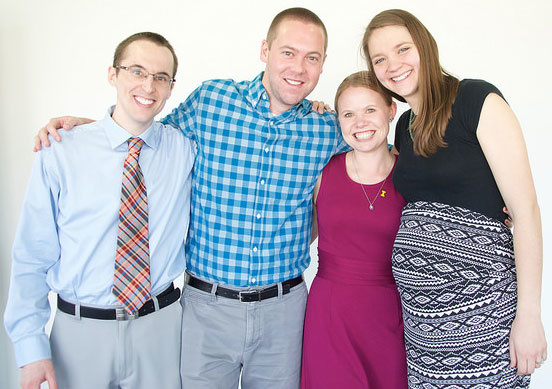When Whitney Kaefring, of Solon, Iowa, decided she wanted to be a doctor, she was already pretty sure that she’d like to practice medicine in a small, rural Iowa community. So when the email arrived announcing the launch of the UI Carver College of Medicine Rural Iowa Scholars Program (CRISP), she was thrilled.
“My first thought was, ‘Oh my gosh, this is perfect!’” she says. “I already thought I wanted to go into family practice, and I knew I loved small-town Iowa, so this seemed like the perfect opportunity for me.”
CRISP was created to help address the shortage of doctors practicing in rural Iowa—recent data from the American Medical Association (AMA) places Iowa 43rd in the country in terms of access to direct-patient-care physicians. The program admits four incoming medical students each year; Kaefring was in the inaugural class of CRISP students in 2012. The students follow the same medical curriculum as their peers, but throughout their four years of medical education, they are exposed to different elements of rural medicine through targeted mentorships, seminars, research experiences, and electives.
CRISP graduates are eligible for up to $100,000 in loan repayment if they complete residency training in a qualifying primary-care specialty and subsequently practice for at least five years in a small Iowa community with a population less than 26,000 and located more than 20 miles from a city of 50,000 people.
Since CRISP began at the UI Carver College of Medicine, the state of Iowa has also launched a similar initiative called the Rural Iowa Primary Care Loan Repayment Program, which offers loan repayment in return for practicing medicine in a small Iowa town.
Despite a few moments of doubt—orthopedic surgery really caught her attention—Kaefring’s interest in rural medicine has remained strong throughout medical school. Moreover, she says she is grateful for the structure provided by CRISP that has allowed her to hone her interest and develop the specific skills and knowledge she’s likely to need as a small-town doctor in rural Iowa. For example, an agricultural medicine course offered through the UI College of Public Health covered medical issues unique to rural settings, such as farm-machinery accidents, which are a significant cause of death and disability in rural communities.
Kaefring says that perhaps the most surprising aspect of her education has been learning the true scale of the need for physicians in rural areas.
“I always knew there was a need for more doctors to practice in rural areas of the state,” she says. “But the number of available open jobs was astounding.”
Although the AMA data actually ranks Iowa quite high for Kaefring’s chosen specialty of family medicine (6th), data compiled by the the Office of Statewide Clinical Education Programs (OSCEP) at the UI Carver College of Medicine for 2015–16 lists 182 practice opportunities in Iowa for family physicians, 109 (60 percent) of which are in communities with populations under 25,000.

On March 18, at Match Day, Kaefring and her classmates in the inaugural class of CRISP students—Elizabeth Dupic, Kale Manuel, and Jesse Van Maanen—learned where they will do their residency training.
Kaefring matched to the family medicine residency program at UI Hospitals and Clinics; Dupic to the family medicine residency program at Broadlawns Medical Center in Des Moines; Manuel to the psychiatry residency program at University of Michigan; and Van Maanen to the general surgery residency program at the University of South Dakota.
As this first group of CRISP graduates moves on to the specialty training provided by their residencies, Kaefring is well aware of the scope of the rural physician shortage. But she is eager to play her part to improve access to care for families who live and work in rural Iowa.
“In the future, I would hope to practice in a small town, probably less than 4,000 or 5,000 people. I really like the very strong sense of community that those small towns offer,” she says.
Match Day at the UI Carver College of Medicine
Among this year's graduating class of 150 students, 52 percent (78 students) chose residencies in primary-care specialties, which include family medicine, internal medicine, obstetrics and gynecology, and pediatrics. There were 24 matches in family medicine programs, 24 in internal medicine, nine in obstetrics and gynecology, and 21 in pediatrics.
The top three non-primary care specialties were emergency medicine, with 11 matches; psychiatry, with nine; and surgery, with eight.
Among this year's graduates, 50 will remain in Iowa for their first year of postgraduate training, and 40 of these 50 students will train next year at UI Hospitals and Clinics.
Geographically, the most popular state after Iowa for first-year training was Minnesota, with 13 graduating students beginning their residencies there. Illinois, Missouri, and Wisconsin will each receive 10 UI graduates.
Match results for 2016, including individual results by name, state, and specialty, are available online at www.medicine.uiowa.edu/md/match.
The National Residency Matching Program (NRMP) helps place graduating medical students in residency programs. Most of the students who will earn medical degrees at the UI this year (145 of the 150 students) participated in the NRMP. Four students secured residencies through the armed forces, and one student opted to defer residency training.